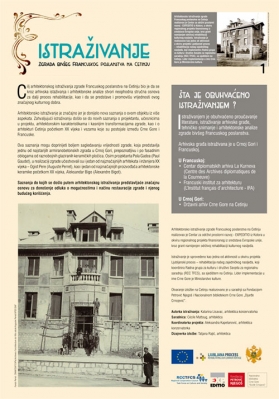 The aim of the architectural study of the French Embassy building in Cetinje, was to through archival explorations, and architectural analysis create the necessary professional base for further rehabilitation process, as well as to present and promote the value of this important cultural property.
The aim of the architectural study of the French Embassy building in Cetinje, was to through archival explorations, and architectural analysis create the necessary professional base for further rehabilitation process, as well as to present and promote the value of this important cultural property.
Architectural research is important because it has brought new information about this property from many aspects. Research resulted in new knowledge about the designer, project participants, architectural features and the subsequent building transformations, as well as Cetinje arhitekturi in the early twentieth century and the relationships that existed between Montenegro and Francuske.
These findings may contribute to better understanding of the building value, which represents one of the oldest reinforced concrete buildings in Montenegro, recognizable by facade cladding of colorful glazed ceramic tiles. Apart from designer Paul Gaudet, in the realization of building was involved one of the most important architects and engineers of twentith century - Auguste Perret, as well as one of the most important manufacturers of archetural ceramics in early twentieth century, Alexandre Bigot. Findings obtained by architectural studies will represent an important basis for decision-making about the possibilities and ways of restoring the building and its future use.
What the survey included?
The study included :
The study of literature , research, archival materials , technical survey and architectural analysis of the former French Embassy building.
Archival material has been investigated both in Montenegro and France.
In France:
•Center of diplomatic archives La Courneuve (Centre des Archives diplomatiques works Courneuve )
•French Institute of Architecture ( L' Institut français d' architecture - IFA )
In Montenegro:
• State archives of Montenegro in Cetinje
The architectural study of the French Embassy building in Cetinje was implemented by the Centre for Sustainable Development - EXPEDITIO from Kotor within the regional project funded by the European Union through a grant intended for the sustainable rehabilitation of cultural heritage .
The study was conducted as one of the activities within the project Ljubljana Process - Rehabilitation of our common heritage , which coordinates Work group on Culture and Society Council for regional cooperation (RCC TFCS ) , headquartered in Cetinje . The leader of the implementation on behalf of Montenegro is Ministry of Culture .
The opening of the exhibition in Cetinje was realized in cooperation with the Petrovic Njegos Foundation and National Library of Montenegro " DjurđeCrnojević " .
The author of the research : Katarina Lisavac , architect conservator
Associate: Cécile Mattoug , architect
Project Coordinator : Alexandra Kapetanovic , architect conservator
The designer of the exhibition: Tatjana Rajic , architect


